Tianjin
 From Nwe
From Nwe | Tianjin 天津 |
|
| — Municipality — | |
| Municipality of Tianjin • 天津市 | |
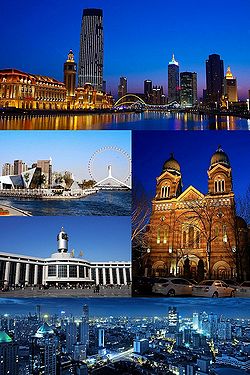
|
|
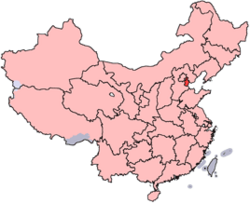
|
|
| Coordinates: 39°08′N 117°11′E | |
|---|---|
| Country | People's Republic of China |
| Settled | ca. 340 B.C.E. |
| Divisions - County-level - Township- level |
13 districts, 3 counties 240 towns and villages |
| Government | |
| - Type | Municipality |
| - CPC Ctte Secretary | Zhang Gaoli |
| - Mayor | Huang Xingguo |
| Area | |
| - Municipality | 11,760 km² (4,540.6 sq mi) |
| - Urban | 174.9 km² (67.5 sq mi) |
| - Metro | 5,606.9 km² (2,164.8 sq mi) |
| Population (2010 census) | |
| - Municipality | 12,938,224 |
| - Density | 1,100.2/km² (2,849.5/sq mi) |
| - Urban | 4,342,770 |
| - Metro | 10,290,987 |
| Time zone | China standard time (UTC+8) |
| Postal code | 300000 – 301900 |
| Area code(s) | 22 |
| GDP Total | CNY 1119.0 billion (USD 177.6 billion) (20th) |
| - Per capita | CNY 84,337 (USD 13,058) (1st) |
| HDI (2008) | 0.875 (3rd) – high |
| Licence plate prefixes | 津A, B, C, D, F, G, H, J, K, L, M 津E (taxis) |
| City flower | Chinese rose |
| Website: (Chinese) www.tj.gov.cn (English) www.tj.gov.cn/english |
|
Tianjin (Chinese: 天津; pinyin: Tiānjīn; Postal map spelling: Tientsin) is one of four municipalities of the People's Republic of China that are administered directly under the central government and have provincial-level status. It is located in the northeastern part of the country along the eastern coast. Tianjin borders Hebei to its south and northeast, while Beijing municipality lies to its north and the Bohai Bay in the Pacific Ocean lies to the east.
The urban area of Tianjin is located along the Haihe River, and is the third largest in China, after Shanghai and Beijing. Its ports, located some distance away from the urban center, are located on the Bohai Gulf in the Pacific Ocean. It serves a vital role as a sea passage route to Beijing, having historically been an important fort and doorway to the capital city. Tianjin is also a communication hub linking North China, Northeast China and Northwest China.
The city boasts the largest man-made harbor in all of China in its northern area, and its Tianjin Port is an important transmission point, linking dozens of provinces and cities in North China with the sea. With over 30 navigation routes leading to more than 300 international ports, Tianjin also serves as a major channel linking the continents of Asia and Europe by sea. All of these factors make Tianjin a vital geographical location of great strategic importance to the People's Republic of China.
History
The land that Tianjin lies upon today was created through a sustained process of the sedimentation of various rivers entering the sea at the Bohai Bay (渤海湾), including the Yellow River, which once entered the sea in this area.
Tianjin began its development into a major port and trading center upon the opening of the Grand Canal of China during the Sui Dynasty. Until 1404, Tianjin was called "Zhigu" (直沽), or the "Straight Port," but in that year, the Emperor Yongle(永乐) renamed the city "Tianjin," which literally means "Heaven Ford." This name refers to the fact that the emperor (son of heaven) once forded the river while on a campaign to wrest the throne from his nephew.
In 1725, Tianjin was promoted to become a prefecture under the authority of the Qing Dynasty. A Tianjin county was established under the prefecture of the same name in 1731 by the Qing.
In 1856, Chinese soldiers boarded The Arrow, a Chinese-owned ship registered in Hong Kong that was flying the British flag and was suspected of piracy, smuggling and of being engaged in the opium trade. These soldiers captured 12 men, and imprisoned them. In response, the British and French sent gunboats under the command of Admiral Sir Michael Seymour to capture the Taku forts (大沽炮台) near Tianjin in May of 1858. These events helped to initiate the Opium War.
At the end of the first part of the Second Opium War in June of the same year, the Treaties of Tianjin were signed, which officially opened Tianjin to foreign trade. The treaties were ratified by the Emperor of China in 1860, and Tianjin was formally opened to the outside world. Between 1895 and 1900, Britain and France were joined by the empires of Japan, Germany and Russia, and even by countries without other Chinese concessions such as Austria-Hungary, Italy and Belgium, in establishing self-contained concessions in Tianjin, each with its own prisons, schools, barracks and hospitals.
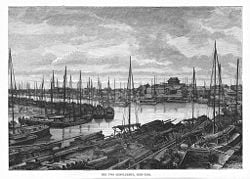
In June 1900, the Boxers(义和团) were able to seize control of much of Tianjin. On June 26, 1900, belligerent European forces heading towards Beijing(北京) were stopped by the Boxers at nearby Langfang(廊坊). They were defeated and forced to turn back to Tianjin, and eventually the foreign concessions also came under siege.
In July of 1900, the Eight Nation United Army attacked and occupied Tianjin, establishing the Tianjin Provisional Government, which was comprised of representatives from each of the occupying forces (Russian, British, Japanese, German, French, American, Austro-Hungarian, and Italian). Tianjin was governed by this council until August 15, 1902 when the city was returned to Qing control. Upon gaining control of the city again, the well-known Qing general, Yuan Shikai (袁世凯) headed efforts to remake Tianjin into a fully modern city.
Tianjin was established as a municipality of China(直辖市)in 1927 under the control of the Republic of China. A decade later, on July 30, 1937, Tianjin fell to Japan as part of the Second Sino-Japanese War. However, the city was not entirely occupied, as the Japanese respected the presence of non-foe foreign concessions in the area. Throughout the duration of Japanese control of the city, Tianjin was ruled by the North China Executive Committee, a puppet state based in Beijing. Japanese occupation lasted until August 15, 1945, when Japan surrendered, officially marking the end of World War II.
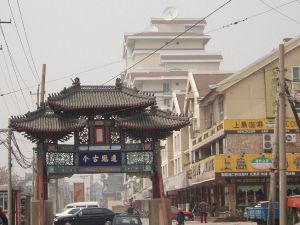
After 1945, Tianjin became a major base for American forces. In December 1946, the rape of a Beijing(北京) female university student by an American soldier, together with a series of rapes that had previously occurred in Tianjin, sparked protests in Tianjin that culminated in a demonstration on January 1, 1947 involving thousands of students. Due to the increased pressure placed by the demonstrators, American troops eventually pulled out of Tianjin in June of 1947.
Following this event and the victory of the Chinese Communist Party over the Nationalists in the Chinese Civil War, Communist forces took over control of Tianjin on January 15, 1949. After communist takeover, Tianjin remained a municipality of China(直辖市, except between 1958 and 1967, when it was demoted to become the capital of Hebei province(河北省省会).
Since China has instituted its economic reforms of the late 1970s, Tianjin has seen rapid development, although it is still lagging behind other important cities like Shanghai(上海), Beijing(北京), and Guangzhou(广州).
Geography
Tianjin lies at the northern end of the Grand Canal of China (大运河), which connects the Yellow(黄河)and Yangtze(长江)rivers.
Tianjin municipality is generally flat and swampy near the coast, but hilly in the far north, where the Yanshan Mountains(燕山)pass through the tip of northern Tianjin. The highest point in the municipality is Jiushanding Peak on the northern border with Hebei, at an altitude of 1,078 m.
The Haihe River(海河)forms within Tianjin municipality at the confluence of the Ziya River (子牙河), Daqing River(大清河, Yongding River (永定河), North Grand Canal, and South Grand Canal and enters the Pacific Ocean at Tianjin Municipality as well, in Dagu District. Major reservoirs include the Beidagang Reservoir in the extreme south (in Dagang District) and the Yuqiao Reservoir in the extreme north (in Ji County).
The urban area of Tianjin is found in the south-central part of the Municipality. In addition to the main urban area of Tianjin proper, the coast along the Bohai Bay is lined with a series of port towns, including Tanggu(塘沽)and Hangu(汉沽).
Tianjin's climate is a monsoon-influenced humid continental climate (Koppen climate classification Dwa) characterized by hot, humid summers, due to the monsoon, and dry, cold winters, due to the Siberian anticyclone. Average highs in January and July are 36 degrees F (2C) and 87 degrees F (31C) respectively. Spring is windy but dry, and most of the precipitation takes place in July and August. Tianjin also experiences occasional spring sandstorms which blow in from the Gobi Desert and may last for several days.
Major rivers and lakes:
- Haihe River
- Liujian River
- Yongding River
- New Yongding River
- Qianqilihi Lake
Administrative divisions
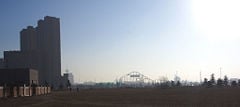
Tianjin is divided into 18 county-level divisions, including 15 districts and 3 counties. Six of the districts govern the urban area of Tianjin:
- Heping District (Simplified Chinese: 和平区; Hanyu Pinyin: Hépíng Qū)
- Hexi District (河西区 Héxī Qū)
- Hebei District (河北区 Héběi Qū)
- Nankai District (南开区 Nánkāi Qū)
- Hedong District (河东区 Hédōng Qū)
- Hongqiao District (红桥区 Hōngqiáo Qū)
Three of the districts govern towns and harbours along the seacoast:
- Tanggu District (塘沽区 Tánggū Qū)
- Hangu District (汉沽区 Hàngū Qū)
- Dagang District (大港区 Dàgǎng Qū)
- These districts collectively make up the economic development zone of Binhai.
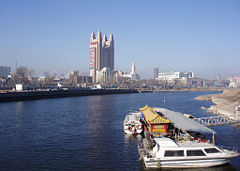
Four of the districts govern satellite towns and rural areas close to the urban center:
- Jinnan District (津南区 Jīnnán Qū)
- Dongli District (东丽区 Dōnglì Qū)
- Xiqing District (西青区 Xīqīng Qū)
- Beichen District (北辰区 Běichén Qū)
Two of the districts as well as the three counties govern towns and rural areas further away from the urban center:
- Baodi District (宝坻区 Bǎodǐ Qū) — Baodi County before 2001
- Wuqing District (武清区 Wǔqīng Qū) — Wuqing County before 2000
- Ji County (蓟县 Jì Xiàn)
- Jinghai County (静海县 Jìnghǎi Xiàn) [1] (Chinese)
- Ninghe County (宁河县 Nínghé Xiàn)
In addition, the Tianjin Economic and Technological Development Area (TEDA) is not a formal level of administration, but nevertheless enjoys rights similar to a regular district.
These districts and counties are further subdivided, as of December 31, 2004, into 240 township-level divisions, including 120 towns, 18 townships, 2 ethnic townships and 100 subdistricts.
Economy
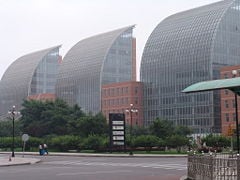
Farmland takes up about 40 percent of Tianjin Municipality's total area. Wheat, rice, and maize are the most important crops, while fishing is important along the coast.
Tianjin has a sizable mineral base, including: manganese, boron, gold, tungsten, molybdenum, copper, aluminum, lead, actinium, zinc, limestone, and natural oilstone. Crude oil and natural gas are the main fuels. Tianjin has deposits of about 1 billion tons of petroleum, with Dagang District containing numerous important oilfields. Salt production is also important, with Changlu Yanqu being one of China's most important salt production areas. Geothermal energy is another significant resource of Tianjin.
Tianjin is also an important industrial base. Major industries include petrochemical industries, textiles, car manufacturing, mechanical industries, and metalworking.
The nominal GDP for Tianjin was 433.8 billion yuan (US$54.4 billion) in 2006, a year-on-year increase of 14.4 percent. [2]
In 2006, per capita GDP was 40,961 yuan. The manufacturing sector was the largest (53.2 percent) and fastest-growing (19.8 percent) sector of Tianjin's economy. Urban disposable income per capita was 14,283 yuan, a real increase of 13 percent from the previous year. Rural pure income per capita was 7,942 yuan, a real increase of 13 percent from the previous year.
Transportation


The Tianjin tram network was awarded to a Belgian company in 1904 and opened in 1906. It was the first city-wide tram system in China. Since then, the government has built numerous additional lines, so that there were 402 bus lines in the city as of 2004. [3](Chinese)
Construction work on the Tianjin Metro started on July 4, 1970. It was the second metro to be built in China and began running in 1984. The metro service was suspended on October 9, 2001 in order to make way for new modifications. The new metro is called "Tianjin Metro Line 1," and was completed 2005. The track runs about 26 kilometers and has a total of 22 stations.
There is also a light railway line in the city, the Binhai Mass Transit line. The line runs between downtown Tianjin and TEDA (Tianjin Economic Development Area) in the seaside region. The eastern part of the line began service on March 28, 2004.
There are several railway stations in the city, with Tianjin Railway Station as the principal one. It was built in 1888, and initially, the station was located at Wangdaozhuang (S: 旺道庄 / T: 旺道莊). The station was later moved to Laolongtou (S: 老龙头 / T: 老龍頭) on the banks of the Haihe River in 1892, so the station was renamed Laolongtou Railway Station. The station was rebuilt in 1988. The rebuilding work began on April 15, 1987 and was finished on October 1, 1988. The Tianjin Railway Station is also locally called the 'East Station', due to its geographical position.
Tianjin West Railway Station and Tianjin North Railway Station are also major railway stations in Tianjin. There is also Tanggu Railway Station is located in the important port area of Tanggu District, and TEDA Railway Station located in TEDA, to the north of Tanggu.
Construction on the new Beijing-Tianjin high-speed rail passenger line began on July 4, 2005, and was completed in time for the 2008 Summer Olympics.
Tianjin Binhai International Airport (ZBTJ) is located to the east of the urban area, in Dongli District.
Demographics
At the end of 2004, the population of Tianjin Municipality was 10.24 million, of which 9.33 million were holders of Tianjin hukou (permanent residence). Among Tianjin permanent residents, 5.56 million were urban, and 3.76 million were rural. [4]
The majority of Tianjin residents are Han Chinese. Minorities include Hui, Koreans, Manchus, and Mongols.
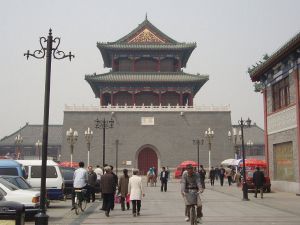
| Ethnic groups in Tianjin, 2000 census | ||
|---|---|---|
| Nationality | Population | Percentage |
| Han | 9,581,775 | 97.29 percent |
| Hui | 172,357 | 1.75 percent |
| Manchu | 56,548 | 0.57 percent |
| Mongol | 11,331 | 0.12 percent |
| Korean | 11,041 | 0.11 percent |
| Zhuang | 4055 | 0.041 percent |
| Tujia | 3677 | 0.037 percent% |
Excludes members of the People's Liberation Army in active service.
Source: Department of Population, Social, Science and Technology Statistics of the National Bureau of Statistics of China (国家统计局人口和社会科技统计司) and Department of Economic Development of the State Ethnic Affairs Commission of China (国家民族事务委员会经济发展司), eds. Tabulation on Nationalities of 2000 Population Census of China (《2000年人口普查中国民族人口资料》). 2 vols. (Beijing: Nationalities Publishing House (民族出版社), 2003).
Media
Tianjin People's Broadcasting Station is the major radio station in Tianjin. Broadcasting in nine channels, it serves most of North China, as well as parts of East and Northeast China, reaching a total audience of over 100 million.[5] (Chinese)
Tianjin Television, the local television station, broadcasts in nine channels. It also boasts a paid digital channel, featuring home improvement programs. [6] (Chinese) Both the radio and television stations are now branches of the Tianjin Film, Radio and Television Group, established in October of 2002. [7] (Chinese)
Major local newspapers include the Tianjin Daily and Jin Wan Bao (literally meaning, "tonight newspaper"), which are the flagship papers of the Tianjin Daily Newspaper Group and Jinwan Mass Media Group, respectively.
Education
The level of education in Tianjin has improved tremendously over its past conditions. The municipality stands well above the national average in terms of its level of education, but appreciably lower than that of the other two major cities in China, Beijing and Shanghai.
According to statistics from 2000, general universities and colleges in the city had 117,700 undergraduates including 45,500 new entrants and 19,000 graduating seniors. In addition, the city had a total of 2,168 enrolled graduate students for doctorate degrees and 10,392 students for Masters degrees. In general, a comprehensive higher learning system has been formed, with various disciplines including sciences, engineering, agriculture, medical science, teaching, finance and economics, liberal arts, foreign languages, arts and physical culture.
Besides higher education institutions, there were 80 general secondary specialized schools with 89,500 students enrolled and 23,300 graduated. Various degrees of vocational or technical education and adult education have also continued to develop in Tianjin, and the 9-year compulsory education policy has been well established in the city. In 2000, there were 690 regular high schools enrolling roughly 922,400 students, and several senior vocational secondary schools enrolling 74,600 students. The number of primary schools was 2,323, with a total of 717,100 pupils. The enrollment rate of primary-school-age pupils was 99.99 percent, which was well above the national average.
Colleges and universities
Under the national Ministry of Education:
- Tianjin University (天津大学) (founded 1895, first university in China)
- Nankai University (南开大学) (founded 1919)
Under the national Civil Aviation Authority:
- Civil Aviation University of China (中国民航大学)

Under the municipal government:
- Hebei University of Technology (河北工业大学) (founded 1903)
- Tianjin Academy of Fine Arts (天津美术学院)
- Tianjin Agricultural College (天津农学院)
- Tianjin Conservatory of Music (天津音乐学院)
- Tianjin Foreign Studies University (天津外国语大学)
- Tianjin Institute of Physical Education (天津体育学院)
- Tianjin Medical University (天津医科大学)
- Tianjin Normal University (天津师范大学)
- Tianjin Polytechnic University (天津工业大学)
- Tianjin University of Commerce China (天津商业大学)
- Tianjin University of Finance & Economics (天津财经大学)
- Tianjin University of Science & Technology (天津科技大学)
- Tianjin University of Technology (天津理工大学)
- Tianjin University of Technology and Education (天津职业技术师范学院)
- Tianjin University of Traditional Chinese Medicine (天津中医药大学)
- Tianjin Urban Construction Institute (天津城市建设学院)
Foreign institutions:
- The Florida International University Tianjin Center, opened in 2006 as a cooperative venture between the municipal government and the Miami-based university.
Note: Institutions without full-time bachelor programs are not listed.
Culture
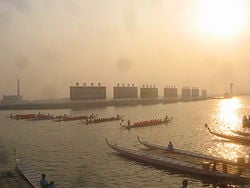
People from urban Tianjin speak a specific Tianjin dialect, which comes under the Mandarin subdivision of spoken Chinese. Despite its proximity to Beijing, the Tianjin dialect sounds quite different from the Beijing dialect, which provides the basis for Putonghua, the official spoken language of the People's Republic of China.
Tianjin cuisine places a heavy focus on seafood due to Tianjin's proximity to the sea. One of the more prominent menus include the Eight Great Bowls (八大碗), a combination of eight mainly meat dishes. The cuisine can be further classified into several varieties, including the rough (粗), smooth (S: 细 / T: 細), and high (高). The Four Great Stews (四大扒) refers actually to a very large number of stews, including chicken, duck, seafood, beef, and mutton.
Tianjin also has several famous snack items. Goubuli (狗不理包子) is a traditional brand of baozi(包子) (steamed buns with filling) that is famous throughout China. Guifaxiang (S: 桂发祥麻花 / T: 桂發祥麻花) is a traditional brand of mahua (麻花)(twisted dough sticks). Erduoyan (耳朵眼炸糕) is a traditional brand of fried rice cakes.
Tianjin is also a respected home base of Beijing opera, one of the most prestigious forms of Chinese opera.
Ma Sanli (马三立)(1914 - 2003), an ethnic Hui and longtime resident of Tianjin, is paramountly respected in China for his xiangsheng(相声), a hugely popular form of Chinese entertainment similar to stand-up comedy. Ma Sanli has delivered some of his xiangsheng in the Tianjin dialect(天津话).
Yangliuqing (Green Willows), a town about 15 km west of Tianjin's urban area and the seat of Tianjin's Xiqing District, is famous for its popular Chinese New Year-themed, traditional-style, colorful wash paintings (杨柳青年画). Tianjin is also famous for Zhang's clay figurines (S: 泥人张 / T: 泥人張) which are a type of colorful figurine depicting a variety of vivid characters, and Tianjin's Wei's kites (S: 风筝魏 / T: 風箏魏), which can be folded to a fraction of their full sizes, are noted for their uniqueness and portability.
Historical and Cultural Sites

Sights within the Tianjin urban area include:
- Luzutang (Boxer Rebellion Museum)
- Guwan Shichang 古玩市场 (Antique Market)
- Guwenhua Jie 古文化街 (Ancient Culture Street)
- Wen Miao 文庙 (Confucious Temple)
- Shuishang Gongyuan 水上公园 (Water Park)
- TV Tower (天津电视塔)
- Shijia Dayuan 杨柳青:石家大院 (Shi Family Residence)
- Temple of Great Compassion 大悲禅院 (Dabeiyuan)
- Tianhougong(天后宫)
- Wanghailou Church, site of the 1870 Tianjin Massacre 望海楼教堂
- Xikai Church 西开天主教堂
- Zhou Enlai Memorial Hall 周恩来纪念馆
Sights outside the Tianjin urban area, but within the municipality, include:
- Fort Dagukou, Qing Dynasty-era cannon battlement 大沽口
- Huangyaguan Great Wall 黄崖关
- Mount Panshan盘山:京东第一山
Sports teams based in Tianjin include:
Chinese Football Association Super League
- Tianjin Teda FC (天津泰达俱乐部)
China Baseball Association
- Tianjin Lions
See also
- 天津 ("Celestial ford") is also the name of an asterism in the Chinese constellation of Girl Mansion (女宿)
- Gao Lingwen, founder of Tianjin's first public school
- List of cities in the People's Republic of China by population
- American, British, French, Italian, Belgian, Russian and Japanese Concessions in Tianjin
References
ISBN links support NWE through referral fees
- Hershatter, Gail. The Workers of Tianjin, 1900-1949. Stanford, CA: Stanford University Press, 1986. ISBN 9780804713184.
- Kwan, Man Bun. The Salt Merchants of Tianjin State-Making and Civil Society in Late Imperial China. Honolulu: University of Hawai'i Press, 2001. ISBN 9780824822750.
- Rogaski, Ruth. Hygienic Modernity: Meanings of Health and Disease in Treaty-Port China. University of California Press, 2004. ISBN 9781417585038.
External links
All links retrieved March 12, 2020.
- Official government website (in Simplified Chinese)
- Overview of Tianjin
- People's Daily
- Tianjin travel guide
| Province-level divisions administered by the People's Republic of China (PRC) | |
|---|---|
| Provinces | Anhui · Fujian · Gansu · Guangdong · Guizhou · Hainan · Hebei · Heilongjiang · Henan · Hubei · Hunan · Jiangsu · Jiangxi · Jilin · Liaoning · Qinghai · Shaanxi · Shandong · Shanxi · Sichuan · Taiwan · Yunnan · Zhejiang |
| Autonomous regions | Guangxi · Inner Mongolia · Ningxia · Tibet (Xizang) · Xinjiang |
| Municipalities | Beijing · Chongqing · Shanghai · Tianjin |
| Special administrative regions | Hong Kong · Macau |
|
|||||||||||||||||
Credits
New World Encyclopedia writers and editors rewrote and completed the Wikipedia article in accordance with New World Encyclopedia standards. This article abides by terms of the Creative Commons CC-by-sa 3.0 License (CC-by-sa), which may be used and disseminated with proper attribution. Credit is due under the terms of this license that can reference both the New World Encyclopedia contributors and the selfless volunteer contributors of the Wikimedia Foundation. To cite this article click here for a list of acceptable citing formats.The history of earlier contributions by wikipedians is accessible to researchers here:
- Tianjin history
The history of this article since it was imported to New World Encyclopedia:
- History of "Tianjin"
Note: Some restrictions may apply to use of individual images which are separately licensed.
↧ Download as ZWI file | Last modified: 02/04/2023 04:45:54 | 74 views
☰ Source: https://www.newworldencyclopedia.org/entry/Tianjin | License: CC BY-SA 3.0
 ZWI signed:
ZWI signed: KSF
KSF